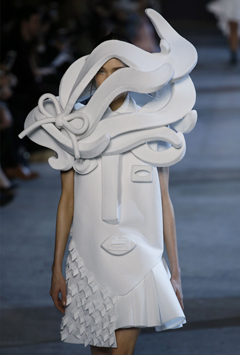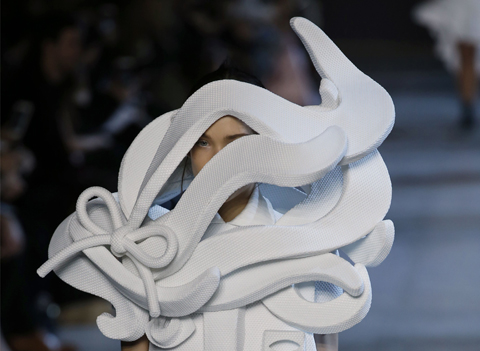 It was probably before the time of his front row stars singers Fergie and Beth Ditto - but they laughed and applauded nonetheless at Jean Paul Gaultier's fashion homage to the Palace club, France's answer to New York's once-famous Studio 54. Here are the highlights of Wednesday's spring-summer 2016 couture collections in Paris.
It was probably before the time of his front row stars singers Fergie and Beth Ditto - but they laughed and applauded nonetheless at Jean Paul Gaultier's fashion homage to the Palace club, France's answer to New York's once-famous Studio 54. Here are the highlights of Wednesday's spring-summer 2016 couture collections in Paris.
The palace party
The glamorous, underground theater was the hippest place in Paris from its inauguration in 1978 by Grace Jones, who famously serenaded the guests with her version of "La Vie en Rose," all the way to its end in 1983. The converted theater represented a golden age in French disco culture and saw Mick Jagger, Jerry Hall and Andy Warhol rub shoulders with designers such as Yves Saint Laurent, Karl Lagerfeld, and, yes, Gaultier himself. It was immortalized in a song by disco-queen - and Salvador Dali muse - Amanda Lear, 69, who sat at the Gaultier show as her music boomed in the soundtrack. Model Farida Khelfa, also a famed Palace regular, laughed and clapped from the front row.
Gaultier's '80s theatre
At Wednesday's show the fashion dial was turned to the beginning of '80s. Sequined pill box hats, strong shouldered tuxedos, jumpsuits, silken pajama suits, and big, big hair dazed guests at the high-energy show delivered with a funky 1980s soundtrack. The litany of stars that graced the famed Palace venue were the inspirations for the designer's myriad 69 looks. Grace Jones was reimagined in a dull shimmering black-and-brown sequined jumpsuit and brown lace robe. Khelfa was spotted on the catwalk in a black perfecto jacket with blood-red nails, lips and shirt. And one look, big blond hair against a black crepe bustier dress with fuchsia satin, must surely have been the glamorous Hall.
Maison Margiela's collage couture
John Galliano demonstrates a seemingly effortless flair in anything he does. For Maison Margiela's spring show, the former Dior man explored the process of couture through the construct of collage and spontaneous fusion. It made for the wackiest styles seen this season - but possibly also the most artful. Twenty-five creations played on billowing volumes, contrasting fabric and styles, and pieces of clothing stitched together in unexpected places. If this sounds like a recipe for a fashion mess, in the hands of Galliano it blossomed.
An off-white trench coat in triple georgette and baggy black riding boots meshed with a layered, pleated skirt, cutting a beautiful feminine silhouette. A silk dress with Chantilly lace was covered at the front with an enveloping layer of sheer black silk that wrapped the entire look - as if blown on the model accidently by the wind. It billowed gracefully backward as the model walked forward - proving true method in the madness.
Valentino's beauty
Valentino designers Pierpaolo Piccioli and Maria Grazia Chiuri described their collection as an "airy and vertical" approach to couture. Yet this description missed so much. It was a truly divine collection of flowing column gowns that played deftly on classical references. Inspired by 1900s fashion designer Mariano Fortuny, the designs mixed up fluid Greco-Roman silhouettes with those of more embellished Eastern Byzantine. A loose, white velvet dress sported gentle gold handmade impressions and a twisted Grecian knot down one arm. Other crepe gowns evoked a tunic silhouette.
They contrasted gently with "eastern" looks, such as a powder rose tulle dress with high collar and arabesque appliques that were lifted with a stylish vermillion band across the bottom. No assessment of a Valentino collection would be fair without mention of the elderly "petites mains" (seamstresses) that are the motors behind this astonishing couture. Many of the dresses in the 66-piece-show took over 1,800 hours to make.
Viktor & Rolf's surreal couture
They say couture is the "ideas factory" for the fashion industry. No one tries to demonstrate this more than Dutch design duo Viktor Horsting and Rolf Snoeren - who in Wednesday's installment conjured up a bizarre series of huge, white fabric figurative face sculptures. The show started with a wearable buttoned white mini-dress - of which the vertical buttoned down part morphed into a large human nose in profile. As the collection progressed - things took a turn for the surreal, at times evoking Pablo Picasso's one-line drawings from the 1950s.
Blown-up segments, which resembled pieces of paper cut into shapes, adorned the looks. They started small - like a face across the bust - but grew in size and complexity until the models' faces were completely obscured by the weird paper-like sculptures. Some fashionistas were worried that one model, with a huge fan covering her face, might crash into the front row. She didn't.-AP











